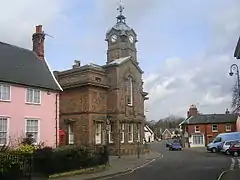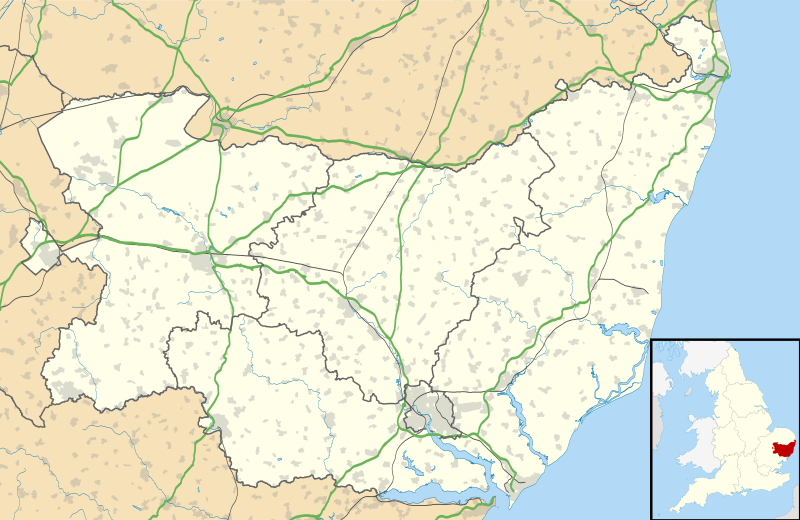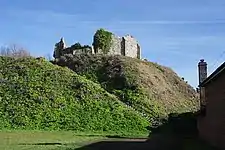Eye, Suffolk
Eye (/ˈaɪ/) is a market town and civil parish in the north of the English county of Suffolk, about 4 miles (6 km) south of Diss, 17.5 miles (28 km) north of Ipswich and 23 miles (37 km) south-west of Norwich. The estimated population in 2018 was 2,347.[2] It lies close to the River Waveney, which forms the border with Norfolk, and on the River Dove. Eye is twinned with the town of Pouzauges in the Vendée department of France.
| Eye | |
|---|---|
 Eye Town Hall | |
 Eye Location within Suffolk | |
| Population | 2,154 (2011)[1] |
| OS grid reference | TM144739 |
| District | |
| Shire county | |
| Region | |
| Country | England |
| Sovereign state | United Kingdom |
| Post town | EYE |
| Postcode district | IP23 |
| Dialling code | 01379 |
| Police | Suffolk |
| Fire | Suffolk |
| Ambulance | East of England |
| UK Parliament | |
Etymology
The town of Eye derives its name from the Old English word for "island, land by water"[3] It is thought that the first settlement on the site was almost surrounded by water and marshland formed by the Dove and its tributaries. The area remains prone to flooding in areas close to the river.[4]
History
There have been Palaeolithic, Mesolithic, Neolithic and Bronze Age finds in and around Eye, but the earliest evidence of settlement dates from the Roman period. It includes buildings and coins dating from about AD 365.[5] A large Anglo-Saxon cemetery with many urned cremations and some furnished inhumations, in use in the 6th century, was excavated near the Waterloo Plantation in 1818.
In 1781 labourers unearthed a lead box by the river at Clint Farm in Eye, 3 miles (4.8 km) south of Scole and 2 miles (3.2 km) south–west of Hoxne. It contained some 600 Roman gold coins from the reigns of Valens and Valentinian I (reigned 364–375), Gratian (375–383), Theodosius I (378–395), Arcadius (395–408), and Honorius (393–423).[5] As such it was the largest hoard of Roman gold coins ever discovered in Britain, similar in content to the Hoxne Hoard.
Eye before the Norman Conquest was one of numerous holdings of Edric of Laxfield, a wealthy, influential Saxon, who was the third largest landholder in Suffolk.[6] After the Norman Conquest, the town's regional importance was confirmed when the Honour of Eye was granted to William Malet, a Norman lord. It continued to be held by royal or noble families until 1823.
In 1066–1071, Malet built a castle as his military and administrative headquarters and started a market that initiated the urbanisation of Eye. In 1086–1087, William's son Robert Malet, tenant-in-chief of the Honour of Eye in the hundred of Hartismere,[6] founded Eye Priory, a Benedictine Priory of St Peter, a cell of Bernay Abbey in Normandy.
Eye began to lose its strategic importance after 1173 when the castle was attacked by Hugh Bigod, 1st Earl of Norfolk during a rebellion against Henry II, and later during the Second Barons' War of 1265, after which it never regained its former status. Its prison continued in use up until the early 17th century, despite a programme of demolishing most of the castle buildings in the 14th century. A windmill built in 1561–1562 stood on the motte until a circular mock keep was built there in 1844. The ruins of the keep remain in place today, and Castle Street and Church Street trace the elliptical shape of the former outer bailey.
Eye was once the smallest borough in the country, its claim based on the 1205 Charter of King John. The charter was renewed in 1408, then many more times by successive monarchs. However, in 1885 the town clerk of Hythe proved that the original charter belonged only to Hythe in Kent, the error having arisen from the similarity of the early English names. The error was confirmed by archivists in the 1950s, but borough status was not discontinued until 1974 after government reorganisation, when Eye became a civil parish but retained a Town Council, a Mayor and the insignia. From 1571 to 1832 Eye returned two MPs, then, following the Reform Act 1832, a single MP until 1983, after which the Eye Constituency became the Suffolk Central constituency. At the time of abolition, Eye was the constituency with the smallest eponymous town, with only around 1500 voters in the constituency actually living in the town of Eye.
The Lordship of the Manor of Eye (Sokemere) and Constableship of the Castle is held by the Palmer family of Haughley in Suffolk. The current Lord is Kieron Palmer of Haughley, in succession to his father Kenneth Palmer. The Manor was held by the Malet family in Norman times, Henry Earl of Brabant, the De Ufford, De la Pole, Cornwallis and Kerrison families as well as King Stephen, Edward I, Mary I and Thomas Beckett in previous years. Known as the Honour of Eye, it consisted of 129 manors and had the right to a court of pie poudre at its Whit Monday market fairs and those of Thrandeston and Finningham.[7]
The earliest mention of industry in Eye records that in 1673 "the women's employ in this town is making of bone lace" and in 1830, "the humbler class of industrious females employ themselves in lace making." It would appear that Eye was at the centre of a localised lace-making industry for many years. The last lacemaker in the town died in 1914. In 1846 Eye Borough Council failed in its attempt to route the new London-Norwich railway line through Eye. The line, completed in 1849, went instead through Diss, which ensured its growth in prosperity and population, while the importance of Eye waned. Eye railway station, at the end of a branch line from Mellis, closed to passengers in 1931 and to freight in 1964.
Eye Airfield, to the north-east of the town, began as RAF Eye, occupied by the 490th Bomb Group of the USAAF's VIII Bomber Command during World War II.
Services and amenities
Eye today has a population of somewhat over 2000.[1] Hartismere School provides secondary education in the town and St Peter and St Paul CE Primary School primary education. The town has a health centre, a library, a police station and a retained fire station. A community hospital opened in 2012, after a previous hospital closed in 2005.[8]
The Town Moors recreation site has play areas that include a skateboard park, football pitches and a large area for woodland walks.
The town's Guildhall is a Grade I listed building now converted into a private residence. Eye Town Hall, an imaginative and unorthodox building dating from 1856 and listed Grade II*, was designed by Edward Buckton Lamb, one of the "rogue architects" of the mid-Victorian neo-Gothic period, criticised for breaking the conventions of Gothic Revival architecture. The weekly country market held in the Town Hall on Wednesdays was shortlisted for the 2009 BBC Food and Farming Awards.
The Bank, Arts Centre has renovated the former HSBC/Midland Sandstone Bank building as an arts and learning centre.
Church of St Peter and St Paul

The Grade 1 listed Church of St Peter and St Paul, dating from the 14th century, is seen as one of the finest in the county.[9][10]
A 13th-century Early English doorway was retained from an earlier building. The 15th and again the 16th century brought periods of new work and renovation. This included installing an altar tomb to William Honnyng in the South or Lady Chapel, and one to Nicholas Cutler to the north-west of the nave. The church was restored in 1868 by James Colling, a London architect. A notable added feature of the church is the magnificent late 15th-century rood screen, which has a loft and rood designed by Ninian Comper in 1925.[9] The screen is thought to originate from Great Massingham Priory in Norfolk.
Notable residents
In birth order:
- Rear-Admiral Sir Charles Cunningham KCH (1755–1834) saw action in the American War of Independence and the French Revolutionary and Napoleonic Wars.
- Concordia Merrel (1886–1962), actor and writer, lived and died in Eye.
- Sir Frederick Ashton (1904–1988), ballet dancer and Choreographer with The Royal Ballet, lived at Chandos Lodge in Eye, behind the local landmark known as the "Crinkle Crackle Wall". He also lived in Yaxley, where he is buried alongside his sister.
- Janet Frame (1924–2004), New Zealand author, rented a cottage at nearby Braiseworth for a period in 1963–1964, where she began a novel, An Adaptable Man, set in the local area. Eye is fictionalised as "Murston".
- Brian Capron (born 1947), actor, was born in Eye.
- Matthew Upson (born 1979), professional footballer, was born in Eye.
- Stuart O'Keefe (born 1991), professional footballer, was born in Eye.
See also
References
- Data view : Population – 5 year age bands – Persons – Census Archived 15 March 2014 at Archive.today, Suffolk Observatory. Parish best estimates from United Kingdom Census 2011. Retrieved 15 March 2014.
- City Population site. Retrieved 28 August 2020.
- Ekwall, Eilert (1960). The concise Oxford dictionary of English place-names (4 ed.). Oxford: Clarendon Press. p. 171. ISBN 0-19-869103-3.
- History of Eye. Retrieved 28 August 2020.
- Robertson, Anne S. (2000), Hobbs, Richard (ed.), An Inventory of Romano-British Coin Hoards, Royal Numismatic Society, p. 404, ISBN 0-901405-48-5
- Open Domesday Online: Eye
- Whites Directory, 1844, p. 330/331.
- Hartismere Hospital in Eye officially opens, Eastern Daily Press, 1 July 2012. Retrieved 15 March 2014.
- Church of St Peter and St Paul, Eye, British Listed Buildings. Retrieved 15 March 2014.
- St Peter and St Paul, Eye, Suffolk churches website. Retrieved 15 March 2014.
- The History of Eye, Clive Paine ISBN 0-9522509-0-X
- S.E. West, 1998, A Corpus of Anglo-Saxon material from Suffolk, East Anglian Archaeology 84, 35–6.
